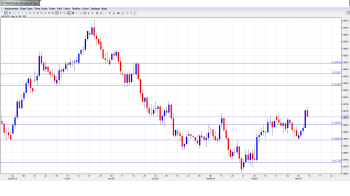AUD/USD had an excellent week, posting gains of about 160 points. The pair closed at 0.9060. The highlights this week are the NAB Business Confidence and Employment Change. Here is an outlook on the major market-movers and an updated technical analysis for AUD/USD.
The Aussie got some help from excellent Australian releases last week, including Building Permits and GDP. In the US, employment numbers looked solid, as Unemployment Claims and Nonfarm Payrolls impressed.
[do action=”autoupdate” tag=”AUDUSDUpdate”/]AUD/USD graph with support and resistance lines on it. Click to enlarge:
- Chinese CPI: Sunday, 1:30. Key Chinese releases can have a major impact on AUD/USD, as China is Australia’s number one trading partner. The indicator has been losing ground, the last two releases coming in at 2.5%. Another drop is expected in the upcoming release, with an estimate of 2.0%.
- NAB Business Confidence: Tuesday, 00:30. Business Confidence is a key indicator which can affect the movement of AUD/USD. The indicator has been moving up and rose to 8 points in the January release. The markets are hoping that the upswing continues in the February release.
- Westpac Consumer Sentiment: Tuesday, 23:30. This is an important indicator as an increase in consumer sentiment usually translates into stronger consumer spending, a key ingredient of economic growth. The indicator has been mired in a nasty slump, posting four declines in the past five releases.
- Home Loans: Wednesday, 00:30. Home Loans is an important gauge of the housing industry as well as consumer spending, as a home is likely the biggest purchase made by a consumer. The indicator disappointed the markets with a decline of 1.9% last month, well below the estimate of +0.5%. The markets are expecting a nice turnaround in February, with the estimate standing at +0.8%.
- MI Inflation Expectations: Thursday, 00:00. The indicator has been very steady, with the past two indicators posting a gain of 2.3%. Higher inflation is bullish for the Australian dollar, so a strong release could bolster the currency.
- Employment Change: Thursday, 00:30. Employment Change is the highlight of the week, and one of the most important economic indicators. The indicator has looked weak, posting two straight declines. The markets are expecting a strong turnaround, with an estimate of 15.3 thousand for February. If the indicator falls short of the estimate, the Aussie could take a hit. The Unemployment Rate, which currently stands at 6.0%, is expected to remain at its current level in the February release.
- Chinese Industrial Production: Thursday, 5:30. Although the indicator continues to post very strong gains, the readings have been dropping, with the January release coming in at 9.7%, a five-month low. The downward trend is expected to continue, with a February estimate of 9.5%.
*All times are GMT.
AUD/USD Technical Analysis
AUD/USD started the week at 0.8903 and slipped to a low of 0.8891, breaking just below support at 0.8891 (discussed last week). The pair then climbed all the way to 0.9133, before retracting and closing the week at 0.9060.
Technical lines from top to bottom:
We begin with resistance at 0.9442. This marked the high point of the pair in November, which saw the Aussie go on a sharp slide and drop below the 0.89 line. This is followed by resistance at 0.9368, which was an important line in mid-November.
Next, there is resistance at 0.9283. This line saw a lot of action in the months of June and July, alternating between resistance and support roles. It has provided steady resistance since November.
0.9180 follows. It is followed by the round number of 0.9000, which was easily breached as the Aussie broke above the 0.91 line. This key line has switched back to a support line to start the week.
0.8893 is the next support line. It saw action early in the week as the pair broke below it before reversing directions and going on an upward tear.
0.8728 marks the low point of an Aussie rally which began in early February and pushed above the 0.90 level.
This is followed by 0.8578, which has remained intact since July 2010.
The final support level for now is 0.8432, which played a key support role in late 2009.
I am bearish on AUD/USD.
The Australian dollar looked sharp last week, but will it manage to stay above the 0.90 level? The US posted strong employment numbers on Friday, and the resulting positive market sentiment could give the greenback a lift early in the week. Australian employment numbers have run into trouble, and a weak Employment Change release could send the Aussie reeling.
- For a broad view of all the week’s major events worldwide, read the USD outlook.
- For EUR/USD, check out the Euro to Dollar forecast.
- For the Japanese yen, read the USD/JPY forecast.
- For GBP/USD (cable), look into the British Pound forecast.
- For the Australian dollar (Aussie), check out the AUD to USD forecast.
- USD/CAD (loonie), check out the Canadian dollar.

